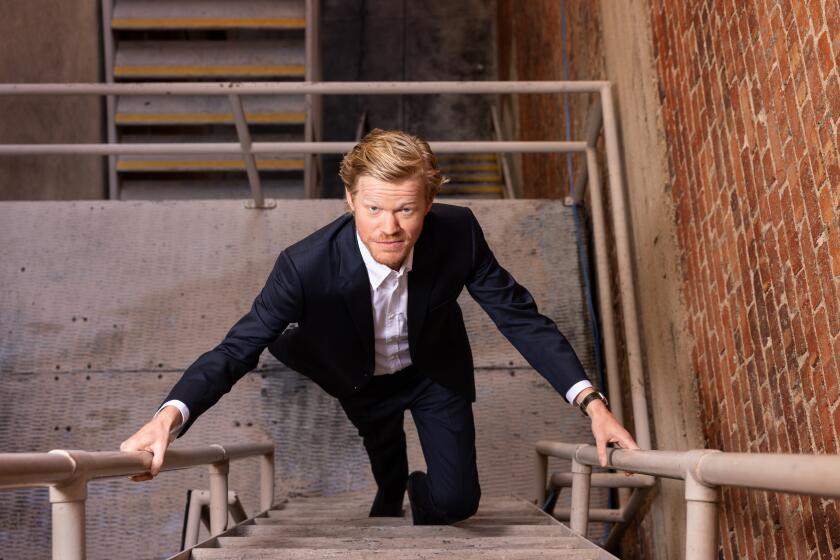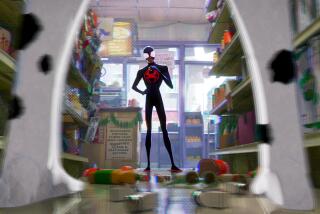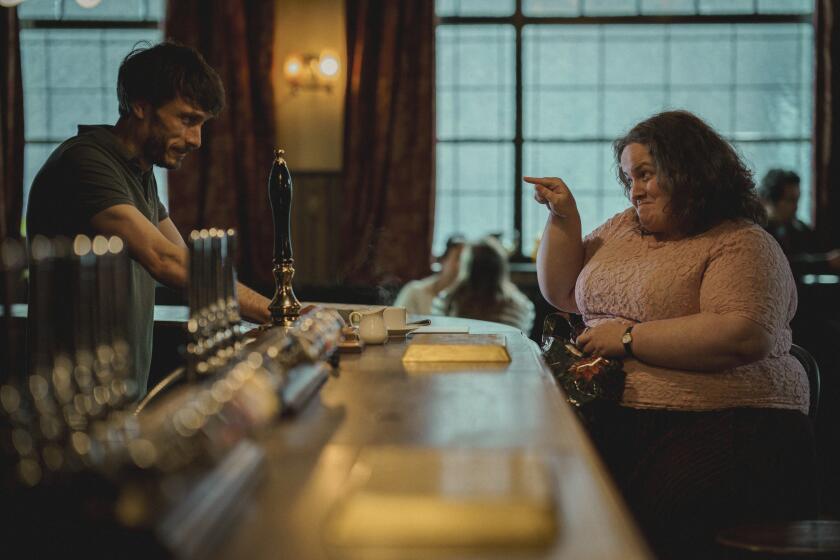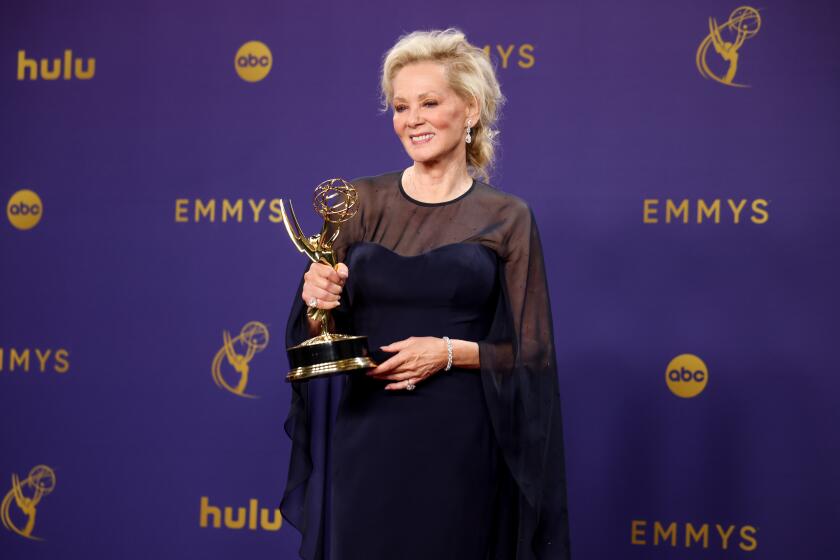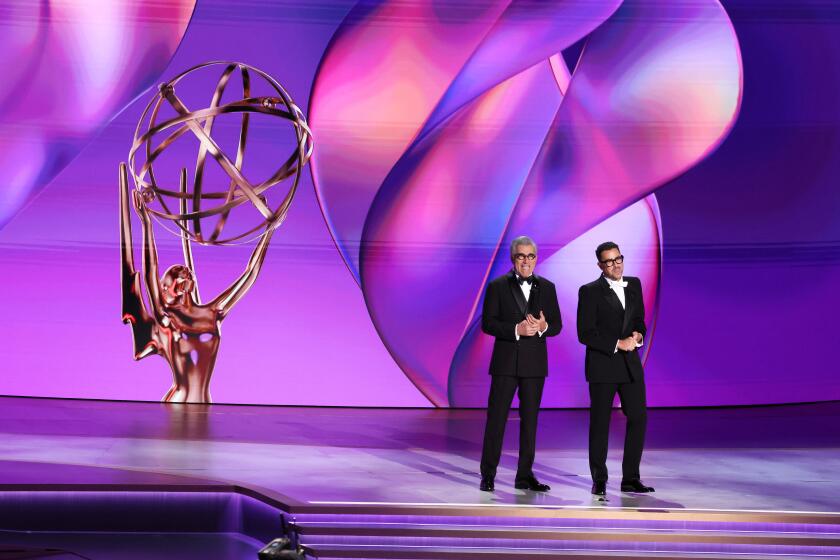How ‘Black Mirror’s’ ‘USS Callister’ sequel became its ‘most ambitious’ episode yet

- Share via
Warning: The following contains spoilers from the “Black Mirror” episode “USS Callister: Into Infinity.”
There’s a reason “Black Mirror” is not known for ongoing stories, says its British creator Charlie Brooker. “I tend to kill everyone or leave them too depressed to function at the end of my story,” he says. “Sequels can be tricky.”
But in the seven years since the anthology series’ Emmy-winning Season 4 episode “USS Callister” galvanized fans with its funny, thrilling, twisty rendering of digital human doubles trapped in a “Star Trek”-like game universe, Brooker and his collaborators knew its story could be extended, past the point where meek programmer Nanette (Cristin Milioti) helped save her cloned self from sadistic game designer Robert Daly (Jesse Plemons), left for dead. Ideas percolated, but so did pitfalls. As Brooker recalled, “There’s lots of corners you’ve painted yourself into, and story logic you have to navigate.” But perhaps more urgently, he said, “If we’ve killed Darth Vader, what do we do?”
What arose was a feature-length follow-up, “USS Callister: Into Infinity,” premiering Thursday on Netflix as part of “Black Mirror’s” seventh season. Taking the spaceship’s crew into a new adventure of real-life and game death, the episode is built around a fresh test of virtual Nanette’s captaincy, and a villainous turn for Daly’s obnoxious business partner Walton (Jimmi Simpson). Plus, adds Brooker, “We just knew, because of what’s unique about our video game premise, we’ve got to have the real world and virtual world meet.” He felt these narrative intricacies required a first-ever “Black Mirror” writers’ room to sort it all out. “This was a different beast, quite complicated. So much fun but a headache to write.”
Milioti likened her separate selves facing each other to “seeing yourself on video or hearing a voicemail you’ve left. I find it to be really jarring.” Real-world Nanette Cole, still an undervalued 9-to-5-er, is impressed by the version of herself that runs a ship, but it’s not mutual for Capt. Cole. “The other one is so disappointed!”
Cristin Milioti speaks about the finale of HBO’s “The Penguin” and why Sofia is her favorite character she’s ever played.
If the fun of returning to familiar sets and costumes after years away came with a kind of “existential motion sickness,” Milioti jokes, navigating the precise choreography to act against herself with specialized cameras presented its own challenge. “You really feel nuts trying to remain present with a memory of yourself, where your hand was, eyelines. It was fascinating and intense, like a dance. For two days, my brain was like an overheated modem.”
Simpson’s virtual Walton (the nice one) returns too, but in a caveman’s loincloth, which required some prefilming training. “I had turned into the full dad bod,” says Simpson, who calls the double-filming days toggling between looks “a full-on marriage of performance and technique. Television is not a film schedule. It’s designed to take up as little time as possible.” But the energy, he says, with much of the original crew returning, was “addictive.”
He enjoyed real-world Walton’s megalomaniacal tech-bro turn as well. “The thoughtlessness and greed is turned to 11, and that was fun,” says Simpson. “People have said it looks like I’m always up to something, so I get to play villains. My mother doesn’t get it at all.”

Returning director Toby Haynes calls the original “a perfect script, a neat potboiler,” but describes “Into Infinity” as “maybe the most ambitious ‘Black Mirror’ episode ever made.” If the original’s cheeky replication of “Star Trek” was its defining aesthetic, this one’s faster-paced, action-meets-farce peril spurred a visual language crafted from gaming. “The guns, the design elements and the visual effects when people get fragged, that was all fun to explore,” he says. The cues of classic sci-fi were still there — including Nanette’s garb deliberately evoking Ripley in “Aliens,” and space combat evoking “Star Wars” — but Haynes also wanted to lean into what makes these stories original. “It’s not pastiche anymore; it’s its own thing,” he notes, “ which is really thrilling.”
The sequel’s most tense inside-the-game face-off takes place in a virtual suburban garage, that mythic place of tech origin, where a wiser, harder Nanette encounters a younger, more innocent Daly (a returning Plemons). Says Brooker, “We always wanted that juxtaposition, with the dynamic slightly altered. She needs his help, and he’s a complex figure. If we hadn’t done a good job, it would have been excruciating to cut from a space battle to two people talking.”
We sat down with the winner of Cannes’ best actor prize to talk about his new movie with Yorgos Lanthimos, Hollywood’s Ozempic craze and his unsettling turn in “Civil War.”
Cue Haynes, who knew how to introduce the door-opening moment with otherworldly suspense: light, mist, a silhouetted Nanette. “I wanted this to be my Spielberg moment, building up to this godlike creep, and Nanette facing her abuser.”
The reunion with Plemons was a favorite scene of Milioti’s. “I like things that explore different facets of people,” she says. “She’s a different person, exhausted and in disbelief that she’s back dealing with this person, and you’re devastated by his loneliness, how badly he wants to connect and how that got twisted. There was so much to excavate. We shot for four days in a room. It felt like a two-hander play.”
With amped-up drama, comedy and action this time around, Brooker knows he’s made something “quite mainstream” for his often bleak, beloved storytelling outlet. “It’s almost family-friendly, apart from the language,” he jokes. “But it still has the distilled essence of ‘Black Mirror,’ those elements and ingredients. Hopefully people feel we did the first one proud.”
More to Read
From the Oscars to the Emmys.
Get the Envelope newsletter for exclusive awards season coverage, behind-the-scenes stories from the Envelope podcast and columnist Glenn Whipp’s must-read analysis.
You may occasionally receive promotional content from the Los Angeles Times.

